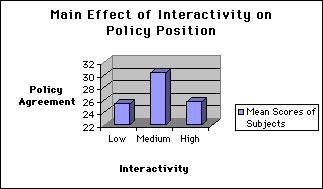Media Effects Research Lab - Research Archive
Reactivity vs. interactivity:
Student Researcher(s)
Justin Brown (Ph.D Candidate);
Sriram Kalyanaraman (Ph.D Candidate);
Faculty Supervisor
FOR A COMPLETE REPORT OF THIS RESEARCH, SEE:
Sundar, S. S., Brown, J., & Kalyanaraman, S. (1999, May). Reactivity vs. interactivity: Impression formation effects of message contingency in political websites. Paper presented to the Communication and Technology Division at the 49th annual conference of the International Communication Association (ICA), San Francisco.
INTRODUCTION
A previous study (Sundar, Hesser, Kalyanaraman, & Brown, 1998) examined the relationship between website interactivity and psychological affinity toward a candidate on a website. The present study attempts to posit the existence of two distinct conceptualizations of website interactivity-the Dialogue View and the Contingency View. The previous study (Sundar et al, 1998) investigated the psychological effects of interactivity using the Dialogue conceptualization. This study was designed to replicate it by using the Contingency View. Specifically, it examines the relationship between website interactivity, the level of political apathy and the level of positive impressions of the candidate as well as his policy positions.
HYPOTHESES
The present study operationalized three levels of website interactivity based on the Contingency model of interactivity. This leads to the following hypothesis:
H1: Participants' perceptual ratings of a website's interactivity will be a direct positive function of the degree of message contingency present in the site.
If message contingency is psychologically relevant to subjects' perception of interactivity, this study should replicate the main-effect of interactivity found in a previous study (Sundar et al, 1998). This leads to the following hypothesis:
H2: Increased interactivity of a political website leads to more positive impressions of the candidate as well as his policy positions.
According to the Elaboration Likelihood Model, (ELM), attitude change can occur when an individual has the motivation, ability, or involvement to process the central arguments of a message (central route). However, when an individual does not have the resources to process the central arguments of a message, attitude change occurs as a result of some simple cue (peripheral route). This study seeks to measure subjects' impressions of not only the candidate as a person but also his policy positions. Based on ELM, and considering website interactivity as a peripheral cue, impression formation as an indicator of attitude change, and political apathy as an indicator of (lack of) motivation/involvement, the following hypothesis was generated:
H3: The relationship between website interactivity and impression formation proposed in H2 will be more pronounced among apathetic voters than among non-apathetic voters.
METHOD
In a between-participants experiment, sixty participants were randomly assigned to one of three conditions (low interactivity, medium interactivity; high interactivity).The content and layout was similar across all three conditions. After entering the lab, participants were asked to fill out a pre-questionnaire containing measures of political involvement and knowledge. They were then exposed to the website and asked to go through the information as carefully as possible. After exposure, participants were asked to fill out a questionnaire pertaining to measures of impression formation and website content.
RESULTS
The dependent measure of psychological affinity was divided into four factors called 'Caring,' 'Charismatic,' 'Qualified' and 'Appealing.'
H1: Supported. Participants in the low interactivity condition perceived the website as being less interactive than participants in the medium interactivity condition, who in turn perceived it as being less interactive than participants in the high interactivity condition.
H2: Partially supported. This follows an inverted-V pattern. Moderate interactivity seems to enhance candidate's appeal as well as his caring nature, but high interactivity seems to detract from it. Similarly, the level of voter agreement with the candidate's position on policy issues is enhanced with moderate interactivity, but not with high interactivity.
H3: Not supported. The interaction term between interactivity and apathy did not attain statistical significance.
caring policy position

CONCLUSION
An important contribution of this study is that it empirically demonstrates the conceptual distinction between two important views of interactivity in communication research. While previous studies encourage us to consider interactivity as a feature of the medium, the operationalization of interactivity in this study prompts us to consider interactivity as a message feature. The results also show that a non-content feature of online communication such as interactivity can contribute significantly to individuals' psychological responses to mediated content. This finding is of importance to not only traditional media effects researchers but also political communicators. A clear practical implication for website developers is that, when it comes to message contingency, reactivity is sometimes more effective than full interactivity.
For more details regarding the study contact
Dr. S. Shyam Sundar by e-mail at sss12@psu.edu or by telephone at (814) 865-2173

